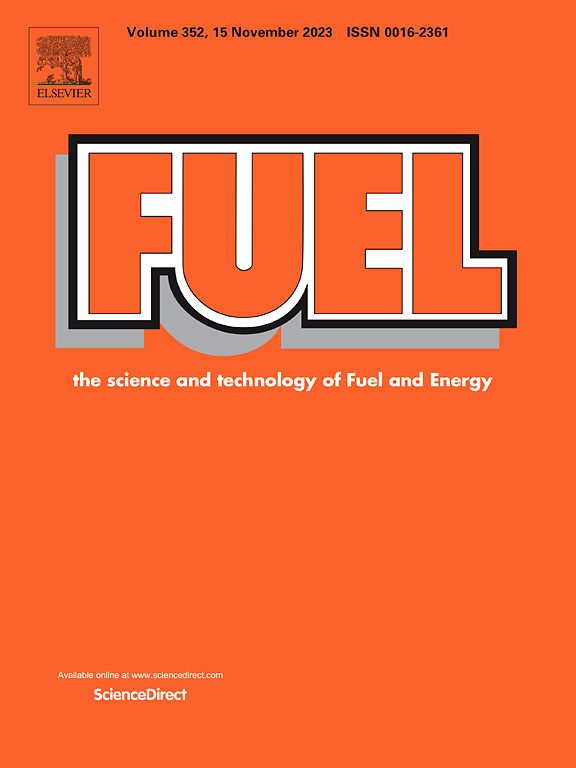利用raschig环形聚丙烯酰胺/纤维素微原纤维水凝胶在固定床柱中对生物柴油和柴油(B15)的连续流动脱除进行了优化
IF 7.5
1区 工程技术
Q2 ENERGY & FUELS
引用次数: 0
摘要
在全球政策的推动下,柴油中生物柴油的含量不断上升,这加剧了保持燃料质量的挑战,特别是在水含量方面。燃料中的水位升高会导致机械故障、腐蚀、微生物生长和燃料性能降低,从而导致维护成本增加和环境问题。复合水凝胶填料为燃料脱水提供了巨大的潜力,特别是在连续工艺中,其基本特性包括强大的机械强度、高亲水性、快速动力学和便于流体流动而不造成压降的几何形状。本研究采用水解和非水解的PAM/MFC(聚丙烯酰胺/纤维素微纤维)水凝胶,形成拉希环,作为固定床柱的填料,用于生物柴油和B15柴油(含有15% (v/v)生物柴油的柴油)的连续脱水。对于生物柴油,水解的PAM/MFC在2.3小时的停留时间后将水含量从952.8 ppm降低到463.6 ppm(去除率51%),符合EN 14214标准。当与含有水解和冻干PAM/MFC水凝胶的柱串联时,水含量进一步降低到约350ppm。水解PAM/MFC在7次循环中保持了性能,其中包括4次使用再生材料,证明了其可重复使用和耐用性。相反,未水解的PAM/MFC水凝胶在2.3小时的停留时间内去除了40%的水,这突出了阴离子水凝胶对生物柴油中更快的水去除动力学的需求。对于B15柴油,同样的非水解材料在17分钟的停留时间内实现了36%的减少,将含水量降低到200 ppm以下,符合EN 590标准。本研究还优化了拉希环型水解PAM/MFC水凝胶的生产,证明了重复使用两次的可行性,减少了约44%的氢氧化钠消耗。此外,在级联系统中洗涤水解的水凝胶显著提高了洗涤效率。一项经济评估表明,在去除生物柴油中的水分方面,水解PAM/MFC水凝胶比其他具有类似性能的阴离子水凝胶具有成本优势,分别比丙烯酰胺-丙烯酸钠共聚物和聚丙烯酸钠水凝胶便宜17%和50%。总的来说,这项研究为工业燃料脱水提供了一种可扩展的、技术上可行的解决方案,提供了一种综合方法,将包装生产的操作效率和符合全球燃料质量标准相结合。本文章由计算机程序翻译,如有差异,请以英文原文为准。

Optimized continuous flow water removal from biodiesel and diesel (B15) using raschig ring-shaped polyacrylamide/cellulose microfibrils hydrogels in fixed-bed columns
The rising biodiesel content in diesel, driven by global policies, intensifies the challenge of maintaining fuel quality, particularly regarding water content. Elevated water levels in fuels can cause mechanical failures, corrosion, microbial growth, and reduced fuel performance, leading to increased maintenance costs and environmental concerns. Composite hydrogel packings offer significant potential for fuel dehydration, particularly in continuous processes, where essential characteristics include robust mechanical strength, high hydrophilicity, rapid kinetics, and geometry that facilitates fluid flow without causing pressure drops. This study addresses these challenges by employing hydrolyzed and non-hydrolyzed PAM/MFC (polyacrylamide/cellulose microfibrils) hydrogels, shaped into Raschig rings, as packing materials in fixed-bed columns for continuous water removal from biodiesel and B15 diesel (diesel fuel containing 15 % (v/v) of biodiesel). For biodiesel, hydrolyzed PAM/MFC reduced water content from 952.8 ppm to 463.6 ppm (51 % removal) after a 2.3-hour residence time, meeting EN 14214 standards. When connected in series with a column containing hydrolyzed and lyophilized PAM/MFC hydrogels, water content was further reduced to approximately 350 ppm. Hydrolyzed PAM/MFC maintained performance over seven cycles, including four with regenerated material, demonstrating its reusability and durability. Conversely, non-hydrolyzed PAM/MFC hydrogels removed 40 % of water during a 2.3-hour residence time, highlighting the need for anionic hydrogels to achieve faster water removal kinetics from biodiesel. For B15 diesel, the same non-hydrolyzed material achieved a 36 % reduction in 17 min of residence time, lowering water content to below 200 ppm, in compliance with EN 590 standards. This study also optimized the production of Raschig ring-shaped hydrolyzed PAM/MFC hydrogels, demonstrating the feasibility of reusing the twice, reducing specific sodium hydroxide consumption by approximately 44 %. Additionally, washing hydrolyzed hydrogels in a cascade system significantly improved washing efficiency. An economic evaluation revealed that hydrolyzed PAM/MFC hydrogels provided a cost advantage over other anionic hydrogels with similar performance in removing water from biodiesel, being 17 % and 50 % less expensive than acrylamide-sodium acrylate copolymers and sodium polyacrylate hydrogels, respectively. Overall, this study presents a scalable and technically viable solution for industrial fuel dehydration, offering an integrated approach that combines operational efficiency in packing production and compliance with global fuel quality standards.
求助全文
通过发布文献求助,成功后即可免费获取论文全文。
去求助
来源期刊

Fuel
工程技术-工程:化工
CiteScore
12.80
自引率
20.30%
发文量
3506
审稿时长
64 days
期刊介绍:
The exploration of energy sources remains a critical matter of study. For the past nine decades, fuel has consistently held the forefront in primary research efforts within the field of energy science. This area of investigation encompasses a wide range of subjects, with a particular emphasis on emerging concerns like environmental factors and pollution.
 求助内容:
求助内容: 应助结果提醒方式:
应助结果提醒方式:


